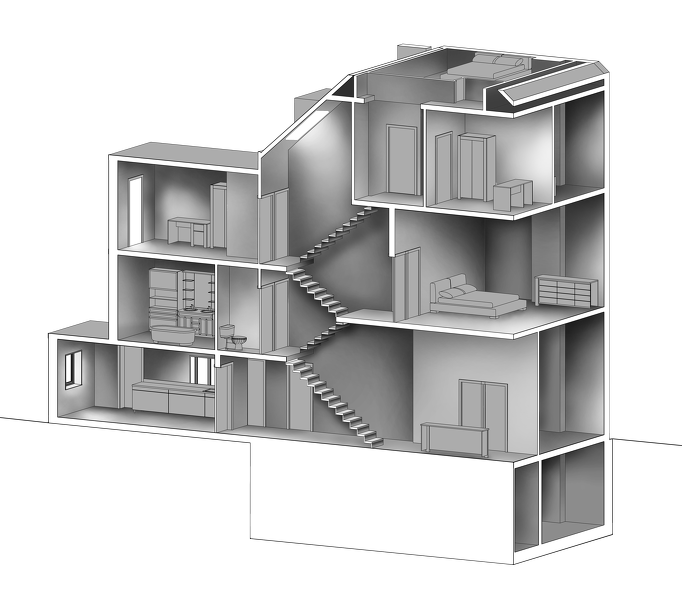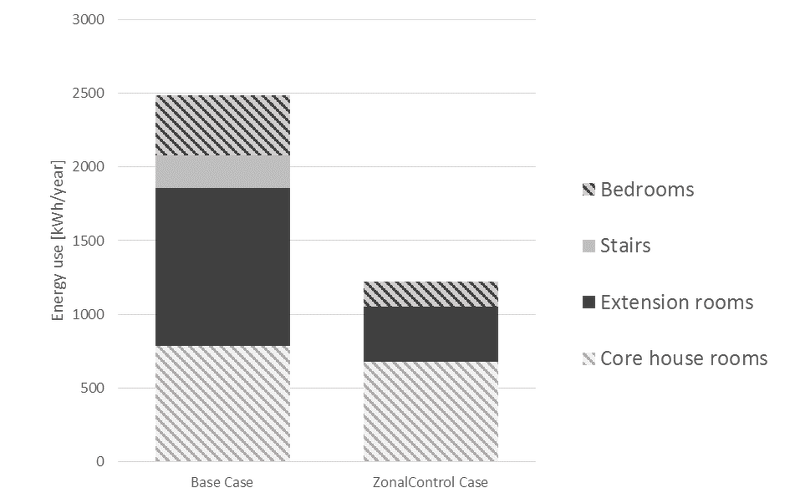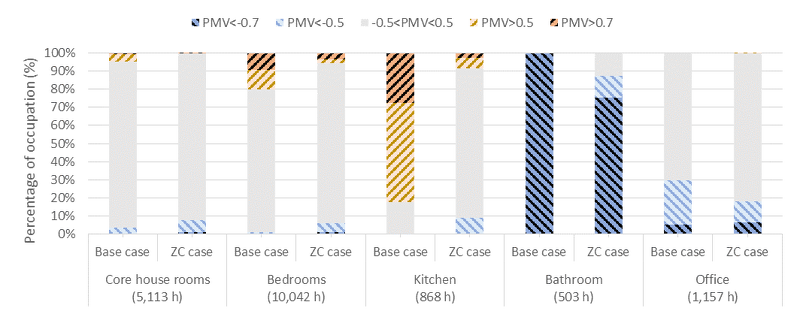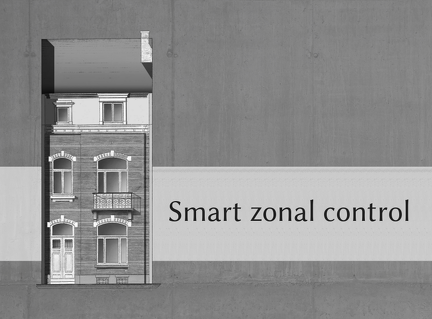1. INTRODUCTION
In Europe, residential buildings are responsible for 25.4% of final energy demands, with 64.7% of global energy use due to space heating. Decreasing the heating needs in dwellings could lead to important energy savings. However, still 75% of European buildings are energy inefficient and the current renovation rate is too low to meet the EU’s efficiency targets. This demands the development of new, easily deployable, energy saving solutions.
Smart zonal control has largely been explored in the literature as a retrofit strategy for un-refurbished houses from an energy saving perspective. Such studies, however, have rarely discussed the impact of a zonal control strategy on thermal comfort, which should also be seen as an important performance indicator. In old buildings with un-insulated thick solid brick walls, in fact, reducing heating duration might lead to lower mean radiant temperatures, which can have a similar impact than air temperature on thermal comfort perception. To offset this radiant temperature reduction, air temperature set points would have to be increased, hence leading to thermal asymmetries.
In response, this paper presents a simulation-based study focusing on the implications on thermal comfort of a smart zonal control strategy applied to the energy retrofit of an un-insulated residential building.

Fig.1: View of the residential model
2. METHOD
The building chosen for this analysis is a traditional maison bruxelloise, a single-family terraced house. This housing type has a characteristic spatial arrangement, making this study relevant to a substantial part of the Belgian and northern European building stock (770,000 houses in Belgium).
This study used the dynamic thermal modelling software TRNSYS 17 with a test reference year (TRY). The method of analysis consisted in the development of two cases from the same simulation model:
- A Base Case, used as a reference, whereas the dwelling has a central heating system with a unique temperature set point of 22°C for all the house and with a programmable thermostat allowing a night setback (16°C from 10pm to 6am). The whole house temperature set point during the day is chosen to provide thermal comfort in the living room (where occupants spend most of their time).
- The Zonal Control Case, whereas each room is heated independently based on times of occupancy, and at an air temperature allowing thermal comfort according to clothing and metabolic activity, and to the mean radiant temperature of surrounding walls. The theoretical zonal control is based on occupancy sensors, i.e. the heating starts/stops instantly when an occupant enters/leaves the room. There is no preheating and it is assumed that emitters can theoretically compensate instantaneously for temperature differences between the temperature set points and the previous states.
The temperature set points have been established by successive iterative adjustments in order to find the air temperature set points corresponding to EN15251 operative temperature ranges. Since operative temperature can be approximated by the mean average between the air temperature and the mean radiant temperature under air velocities lower than 0.2 m/s, sedentary physical activity, and without direct sunlight exposure, air temperature set points were determined to meet the two following conditions for thermal comfort: 1) having PMV values during occupation hours belonging to the category deemed acceptable for existing buildings by the standard EN15251 i.e. 0.7<PMV<0.7; and 2) having a thermal asymmetry between air and mean radiant temperatures under 10K, which is a limitation assessed by Fanger.
3. RESULTS
3.1 Energy use
The total annual heating energy use of the base case was 170.9 kWh/m² (39,999.3 kWh), which is higher than the national average for this typology (terraced houses built before 1945) in Belgium (24,460.8 kWh). The main reasons could be that all the rooms were assumed to be heated at the same temperature, all day long, in a house of large floor area.
The zonal control annual heating energy use was 84.0 kWh/m² (19,650.3 kWh), which led to a substantial reduction compared to the base case and the typology mean value. However, this result should be considered with caution and be interpreted mostly as a theoretical potential due to the simulation-based nature of this work and the above-exposed assumptions.

Fig.2: Energy use for different room categories
3.2 Thermal comfort and asymmetries
From the perspective of the thermal comfort opportunities provided by the smart zonal control strategy, Figure 1 illustrates the distribution of thermal comfort categories in different spaces of the house based on percentage of occupation.
With respect to the base case, the smart zonal control strategy resulted in a slight increase of thermal comfort duration. This was mainly due to the decrease of hours under ‘warm’ conditions (i.e., PMV>0.7). The adjustment of the temperature set points, more suitable to occupancy characteristics, also explained part of the energy use reduction. However, the zonal control also led to an increase of ‘cold’ discomfort (PMV<-0.7 and/or tair–tmean,radiant>10K). This corresponded, respectively, to 3.2% (561 hours) and 4.5% (794 hours) of occupation time for the base case and for the zonal control strategy.
Under zonal control, the core-house rooms had, in general, slightly lower operative temperatures, with 43 hours (0.8% of occupation time during the heating period, or 0.5% of annual occupation time) below comfort conditions. The bedrooms had, in general, warmer conditions in the base case (9.2% of heating period occupation time with PMV>0.7). The reduction of the heating set point and the heating time led to cooler conditions under the zonal control, explaining part of the energy use reduction.
For the bathroom and the office (located in the house extension), the reduction of heating duration led to thermal asymmetries between air and radiant temperatures (in fact, the simulation model assumed that the air temperature set point was achieved instantly). This is due to their shape and location, implying a large external wall area for a limited floor area. Insulating the bathroom and the office in the extension would probably be necessary to provide acceptable comfort conditions under both cases.
4. CONCLUSION
From the results of this study, it can be concluded that smart zonal control offers promising prospects to reduce spatial heating energy use in old un-insulated residential buildings in heating-dominated climates such as Belgium, while also providing significant opportunities for thermal comfort.
However, smart zonal controls might increase thermal asymmetries between air and radiant temperatures, hence requiring further research before these findings can be generalised. Ultimately, this paper outlines the need for a better comprehension of thermal comfort and energy use in residential buildings, particularly under heterogeneous and dynamic indoor heating and occupancy conditions, so as to further develop smart control strategies.


